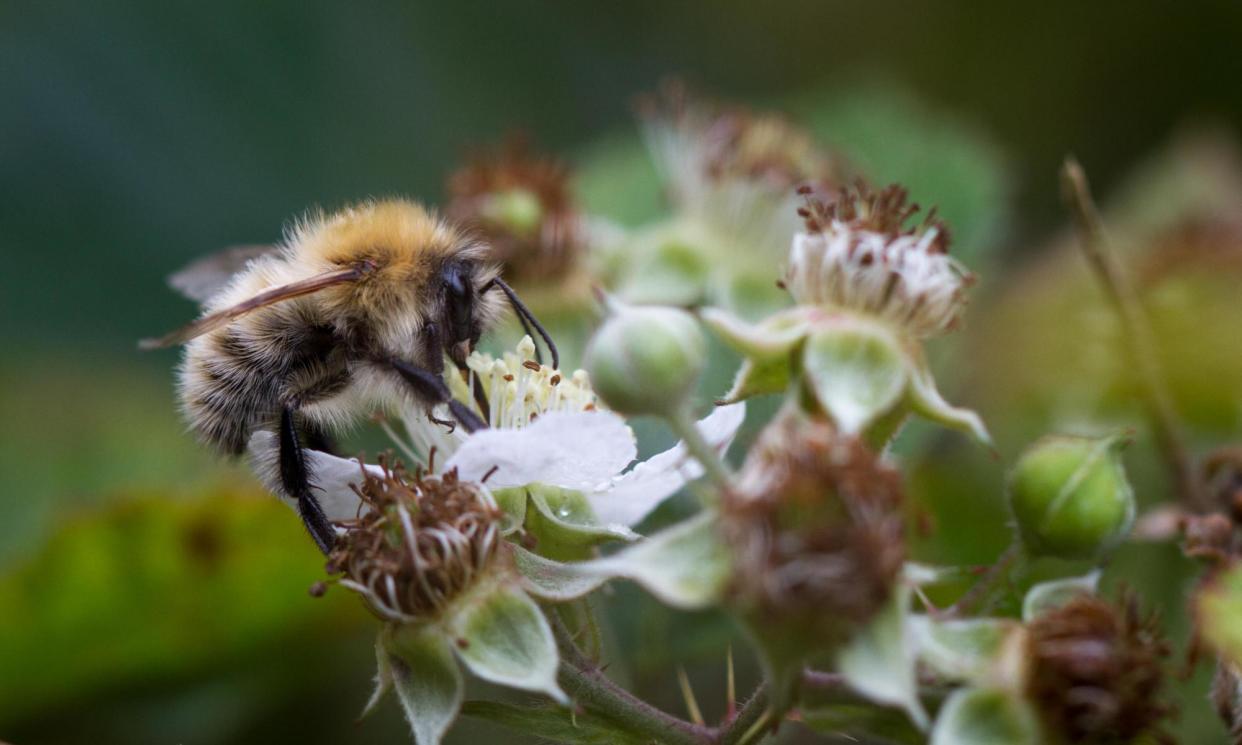Bumblebee nests are overheating to fatal levels, study finds

Bumblebee nests may be overheating, killing off broods and placing one of the Earth’s critical pollinators in decline as temperatures rise, new research has found.
Around the world, many species of Bombus, or bumblebee, have suffered population declines due to global heating, the research said. Bumblebee colonies are known for their ability to thermoregulate: in hot conditions, worker bees gather to beat their wings and fan the hive, cooling it down. But as the climate crisis pushes average temperatures up and generates heatwaves, bumblebees will struggle to keep their homes habitable.
Most bumblebee broods would not survive at temperatures above 36C, the paper, published in Frontiers in Bee Science, concluded. The research team reviewed 180 years of literature, and found that for all bumblebee species studied the optimum temperature range for incubating nests was between 28C and 32C.
Peter Kevan, the lead author of the study, told the Guardian: “If [bumblebees] can’t keep temperatures below what is probably a lethal limit of about 35C, when the brood may die, that could explain why we are losing so many bumblebees around the world, especially in North America and Europe.”
Kevan, who is a professor emeritus at the University of Guelph’s School of Environmental Sciences in Canada, added that the research examined the often-overlooked role of the nest as a “superorganism”.
“Researchers have been looking at foraging behaviour and fanning to keep the brood cool, but there are very few studies that look at the whole nest,” he said. The study argued that nests should be seen as a whole: while some individual bees may be able to cope with heat, if the nest becomes too hot to raise healthy larvae the whole colony will decline.
Dave Goulson, a professor of biology at the University of Sussex, who was not involved in the research, said: “We have known for a long time that bumblebees are cool-climate specialists. Most insects are more abundant in the tropics, but bumblebees are weird in that they are at their most abundant in places like the Alps and Britain.”
They are big and furry as an adaptation to living in cooler places, he said. “There are even some that live in the Arctic, the Bombus polaris. That means an obvious problem with climate change – they are vulnerable to warming.”
When nests overheat, he added, bumblebees work to cool them by flapping their wings, “but if the air outside is too hot, that’s not going to help”.
Goulson said there is already evidence that bumblebees have started to disappear from the warmer edges of their range. “There have been publications showing mountain bumblebees are moving higher as a way to combat warming, but obviously there is a limit to that.”
Related: ‘I dream of bees’: one boy’s encounter with a swarm in Sicily led to a lifetime’s devotion
The paper’s findings, said Goulson, who has spent 30 years studying bumblebees, are “really depressing”. “It is kind of heartbreaking to think that many may disappear.”
Other studies, he said, suggest that the UK “might lose about half our bumblebee species in coming years, depending on the pace of climate change”. Their populations had been declining due to habitat loss, Goulson said. “Now, [with rising temperatures] we have a double whammy.”
Richard Comont, the science manager at Britain’s Bumblebee Conservation Trust, also not part of the study, said he was glad to see the new research. “It’s something that there has been speculation about for a while,” he said.
Bumblebees are important pollinators of wild flowers and crops including tomatoes, runner beans, apples, blueberries, blackcurrants and raspberries. For other pollinators, Goulson said, the outlook under a hotter climate is less clear. Some bee species can cope with warmer temperatures, and some species that now live farther south may move north as temperatures rise, making a new home in the UK. With other pollinators, he said, such as flies, wasps, butterflies, birds and bats, “it’s hard to generalise”.
To stem declines, increasing habitats and decreasing pesticide use could help, Goulson said – but really, “we need to knuckle down” and make sure global temperatures “do not go past 2C” of heating.
Find more age of extinction coverage here, and follow biodiversity reporters Phoebe Weston and Patrick Greenfield on X for all the latest news and features


